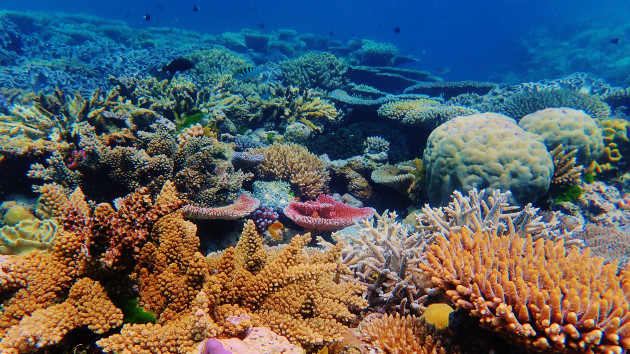
The Sunny Side of Saving Reefs
BreathShare
With summer fast approaching, whether we are laying out at the park, planning family vacations, or sitting by the pool, we should all be layering on our 30 SPF to protect us from all that sunshine (read more about the benefits of getting enough sun here). There are a lot of factors that may ultimately contribute to how we pick our sunscreen, mineral or chemical, lotion or spray, however when wearing that sunscreen at the beach the most important factor we should be considering is whether our sunscreen is reef-safe.
Coral reefs are not just beautiful underwater structures; they are incredibly vital to marine ecosystems. Often referred to as the "rainforests of the sea," coral reefs support a staggering diversity of life, with about 25% of the ocean’s fish depending on healthy coral reefs. They provide essential habitat, food, and breeding grounds for many marine species. On top of their biological importance, reefs protect coastal areas from storms and erosion, and they contribute significantly to local economies through tourism and fishing. Over half a billion people depend on reefs for food, income, and protection.
Coral reefs around the world are in trouble. They are facing multiple threats including ocean acidification, rising sea temperatures, pollution, overfishing, and the impacts of certain sunscreen chemicals. Yes, you read that right—some of the products we use to protect our skin can harm coral reefs.These threats lead to coral bleaching, which happens when coral expel their symbiotic algae as a stress response, and without proper care or alleviation leads to a weakened state and eventually the death of the coral. Without the algae present, the corals are starving.
What's Wrong with My Sunscreen?
The main culprits in sunscreen that pose risks to coral reefs are chemicals like oxybenzone and octinoxate. These substances can increase coral’s susceptibility to bleaching, damage their DNA, and disrupt their development and reproduction. Even in small quantities, these chemicals can have adverse effects when washed off our bodies into the ocean.
According to the National Ocean Service, sunscreen chemicals can affect all levels of marine life:
-
Green Algae: Can impair growth and photosynthesis
-
Coral: Accumulates in tissues. Can induce bleaching, damage DNA, deform young, and even kill.
-
Mussels: Can induce defects in young
-
Sea Urchins: Can damage immune and reproductive systems, and deform young
-
Fish: Can decrease fertility and reproduction, and cause female characteristics in male fish
The chemicals in some sunscreens that can harm marine life include: Oxybenzone, Benzophenone-1, Benzophenone-8, OD-PABA, 4-Methylbenzylidene camphor, 3-Benzylidene camphor, nano-Titanium dioxide, nano-Zinc oxide, Octinoxate, Octocrylene
What Can We Do?
This is where reef-safe sunscreens come into play. Reef-safe or reef-friendly sunscreens are formulated without the harmful chemicals that contribute to coral stress and degradation. Instead, they use physical filters like zinc oxide or titanium dioxide, which protect your skin by sitting on top of it and reflecting UV rays, rather than being absorbed. These ingredients are much less harmful to corals and other marine life.
However, the term "reef-safe" isn't regulated by any governing body, so it's essential to do your homework and read labels carefully. Look for sunscreens that are free from oxybenzone, octinoxate, octocrylene, and other potentially harmful chemicals. It's also a good idea to opt for non-nano zinc oxide or titanium dioxide as these particles are larger and less likely to be ingested by corals.
Byrdie has a list of 2024’s best and truly reef safe sunscreens here. Taking further steps to be as eco-conscious as possible, SustainableJungle also has a list of reef-safe sunscreens that are also in biodegradable packaging here.
Beyond Sunscreen: Other Ways to Protect Reefs
Protecting coral reefs requires more than just switching your sunscreen, although that's a great start. Here are a few more actions you can take to help:
-
Practice responsible snorkeling and diving: Avoid touching reefs or anchoring your boat on the reef, and be aware of where you kick to prevent accidentally breaking the coral
-
Reduce pollution: Dispose of trash properly and use environmentally friendly products whenever possible, avoid using plastic
-
Support conservation efforts: Get involved with or donate to organizations that work to protect ocean habitats
-
Educate others: Share what you’ve learned about coral reefs and the importance of protecting them
Conclusion
Our choices, even as seemingly small as the type of sunscreen we use, can have a big impact on marine ecosystems. By choosing reef-safe sunscreens and taking other protective measures, we can help ensure that coral reefs continue to thrive. This summer while we’re protecting our skin from the sun, why not also protect our coral reefs? After all, a little change in our routine can lead to waves of positive impact for our planet's future.
Thank you for reading,
Breath